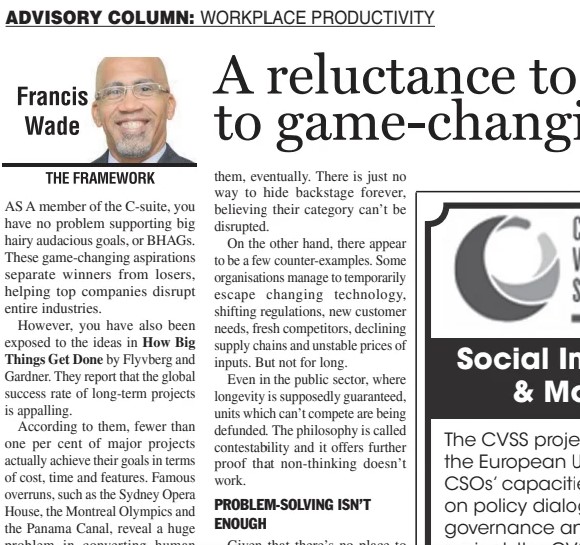As a member of the C-Suite, you may readily support Big Hairy Audacious Goals (BHAGs)—those ambitious, industry-shaping aspirations that separate leading companies from the rest. These high-stakes goals have the power to disrupt entire industries, often turning bold vision into remarkable results.
Yet, you’ve likely also encountered the sobering insights from *How Big Things Get Done* by Bent Flyvbjerg and Dan Gardner. Their research highlights a harsh reality: major projects across the globe frequently fall short. In fact, fewer than one percent of large projects succeed in meeting their goals on time, within budget, and with all intended features. High-profile failures, like the Sydney Opera House, the Montreal Olympics, and the Panama Canal, showcase how challenging it is to turn big dreams into successful outcomes.
So, when a company or organization makes a commitment to a game-changing goal, the odds are, unfortunately, stacked against it. Take the film *Heaven’s Gate* as an example—it ran years over schedule, went massively over budget, and ultimately led to the collapse of United Artists film studio.
But do these statistics mean your company should avoid aiming for breakthrough results? Should the high failure rates discourage organizations from striving for greatness? Here are some reasons why it’s still worthwhile to pursue game-changing goals, rather than settle for incremental improvements.
**#1. There’s No Backstage**
Some executives believe their company can hold on to the status quo indefinitely. While they might talk a good game about innovation, they are content to stick with familiar practices, almost as if disruptions don’t apply to them. But this is like a writer who clings to their typewriter, ignoring new tools like ChatGPT while assuming the market for their work will remain unchanged.
By choosing inaction, these executives inadvertently embrace a “strategy of inertia.” But this strategy often catches up with them—eventually, almost every industry faces a disruption.
Granted, there are a few rare cases of companies that temporarily escape changing technology, shifting customer needs, new competitors, and unstable supply chains. Even in the public sector, where longevity is assumed, departments that can’t keep up are being defunded under a policy of “contestability.” This shows that no organization, public or private, is immune to change.
—
**#2. Problem-Solving Alone Isn’t Enough**
Without a place to hide from change, executives often struggle to shift their thinking after joining the C-Suite. Why? Up until their promotion, they were celebrated for quick wins and problem-solving skills.
Once they reach the top, however, they need to pivot from short-term results to a long-term vision. It’s no longer about fixing issues on the spot; it’s about building a compelling future. This shift requires leaders to let go of their comfort zone and address their blind spots.
For new C-Suite leaders, this shift can feel like a frustrating waste of time. Imagine a strategic planning retreat to set a BHAG: it involves activities like clarifying goals, weighing risks, and challenging assumptions. To leaders accustomed to fast results, these slower, more thoughtful steps may seem pointless.
Some may even prefer the “move fast and break things” mindset that once fueled early Facebook’s explosive growth. But Facebook eventually abandoned this slogan, learning through costly failures that some damage can’t be easily undone.
**#3. Stop Delaying the Inevitable**
It’s a common issue—many companies defer tackling long-term challenges that could take a decade or more to solve. Instead, executive teams focus on easier problems that provide quicker results.
Look around your organization. Are there longstanding issues that have been consistently set aside? Often, it’s because previous leaders failed to establish the BHAGs and long-term plans necessary to address them.
This might sound like bad news, but it doesn’t have to be.
According to innovators like Chunka Mui and Alan Kay, these neglected issues represent opportunities for game-changing innovation. The difference between success and stagnation often lies in a company’s ability to introduce transformative solutions and lead new market categories.
Mui and Kay outline a process that any company can use to shape the future by proactively inventing it. This might sound ambitious, but consider what it could look like if every organization in Jamaica—businesses, government agencies, NGOs, schools, churches, and clubs—invested in the most effective forward-planning practices available.
Back in 2009, the launch of Vision 2030 was a step in the right direction. But now, Jamaicans need to take another step forward: embedding a culture of vision-setting and breakthrough goal creation in every company’s annual planning.
In summary, while aiming for game-changing goals may feel risky, the alternative—sticking to the familiar and hoping for stability—is equally uncertain. For organizations that wish to lead, rather than react, these ambitions remain essential.

